JNTR
Table of contents
- Types of JNTR Bridges
- Demand for JNTR
- Use of Funds
- JNTR Face Value
- JNTR Minting
- Purchasing JNTR
- Auction
- SmartSwap
- Selling JNTR
- Target Investors
- Regulation
- Management Fee
- JNTR Quick Facts
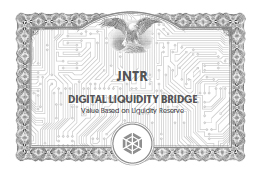
JNTR is a liquidity bridge that serves as a transfer of value between traditional commercial real estate securities (JNTR/ETN and JNTR/STOCK) and digital currencies.
JNTR is a financially engineered decentralized protocol layer on top of the Binance Smart Chain blockchain developed as the exclusive payment method to facilitate trades of Jointer’s stocks (JNTR/STOCK) and bonds (JNTR/ETN)
JNTR’s face value changes based on the liquidity reserve’s calculation every time investors directly purchase JNTR through the daily Auction or through SmartSwap. The face value carries an exponential return potential along with a low risk profile, providing an uncorrelated hedge against volatility in the real estate and crypto markets.
Although holders of JNTR are not entitled to the securities or properties, the JNTR asset is the only method of payment to buy and sell JNTR/ETN or JNTR/STOCK, placing JNTR at the center of the Jointer Syndication Economy. While JNTR is not directly linked to properties it is the only payment method for the asset-backed securities providing indirect face value protection.
Types of JNTR Bridges
The first JNTR bridge is with Binance’s native token, BNB. The JNTR<>BNB bridge allows investors to convert BNB1 to JNTR and then to JNTR/ETN or JNTR/STOCK. Future developments will include support for other blockchains such as JNTR<>BTC, JNTR<>ETH, JNTR<>EOS, and JNTR<>TRON.
JNTR’s Utility Functionality rather than BNB, ETH, or BTC
REITs own approximately $3 trillion in gross real estate assets, with more than $2 trillion from publically listed and non-listed REITs and the remainder from privately held REITs.2 By offering traditional REIT investors 2X leverage on the proven Global Select All REITs Index, the JNTR/ETN asset possesses intrinsic demand amongst these investors.
If Jointer allowed trading for JNTR/ETN or JNTR/STOCK directly against BNB, ETH, or BTC, the entire ecosystem would not have the ability to provide continuous liquidity for investors or would reduce the amount of funds Jointer could invest in Commercial Real Estate.
Overall Ecosystem Support
Using JNTR as a bridge increases the interoperability of the Jointer Liquidity Economy. With the ongoing Jointer Auction bringing in funds for a reserve, JNTR can support liquidity to BNB or BNB based stablecoins for all JNTR/ETN and JNTR/STOCK holders.
JNTR compared to Cryptocurrency and Asset Backed Tokens
JNTR is a financially engineered decentralized protocol layer on top of the Binance Smart Chain designed as the exclusive payment method to buy or sell Jointer’s stocks (JNTR/STOCK) and bonds (JNTR/ETN). It functions as a liquidity bridge and serves as a transfer of value between traditional commercial real estate equity and other blockchain based digital currencies. JNTR’s face value changes based on the Main Reserve’s calculation every time investors directly purchase JNTR through the daily Auction or through other methods such as SmartSwap. This process creates an investment hedge against volatility in the real estate and crypto markets.
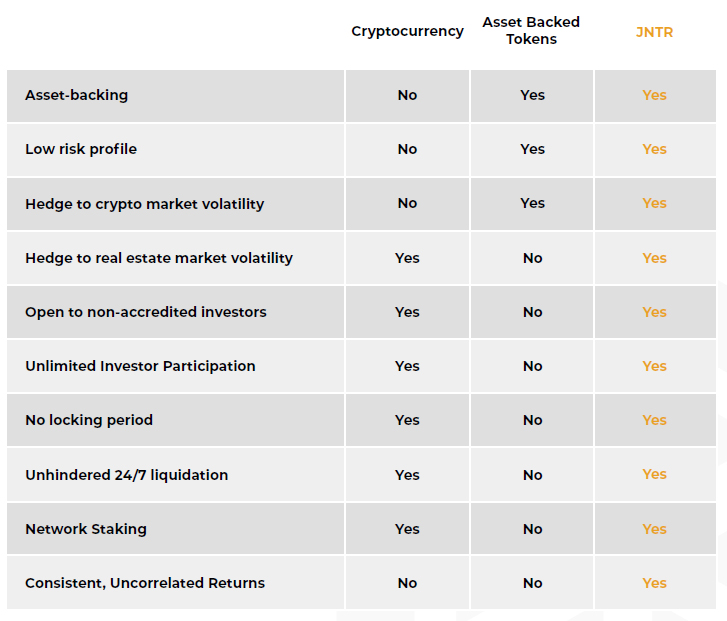
Demand for JNTR
Even though JNTR does not have exposure to Commercial Real Estate, equity, cash flow, or any kind of returns, it still benefits from the strength of the Commercial Real Estate market.
Access to Jointer’s Securities
When sentiment for the market is high, market forces will increase demand for JNTR as the bridge asset without Jointer’s involvement. JNTR acts as a bridge between assets, which in JNTR’s case is a $14 trillion addressable market.3 The Commercial Real Estate and REIT investment markets are far greater than cryptocurrency asset values.4
Must hold JNTR to participate in the Auction
Since investment power is limited to the amount of JNTR held in the investor’s wallet, there is demand from auction participants wanting to hold more JNTR in order to invest in the Auction.
Use of Funds
The use of funds received during the Auction are set up to power a robust and thriving ecosystem to benefit Jointer investors. As a DAO (Decentralized Autonomous Organization), Jointer invests 100% of the funds raised into Commercial Real Estate and Jointer’s liquidity reserve.

90% Commercial Real Estate Property Investments5
Jointer invests in lucrative and thoroughly underwritten deals that meet a stringent standard
10% Liquidity Reserve
Jointer distributes funds directly to Jointer’s Reserves to support the liquidity of JNTR assets
JNTR Face Value
JNTR’s face value is dynamic and based on the market. Before the launch, Jointer will set the value. Ongoing value is not determined by Jointer, rather the face value of JNTR follows the market-driven Jointer Main Reserve.
Initial Value
JNTR’s initial auction face value is static at $0.01 USD. This is the only time JNTR’s face value is static and determined by Jointer.
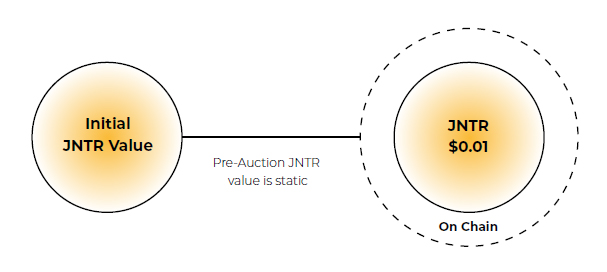
Ongoing Value
An active Jointer Auction directly affects JNTR’s ngoing value since the face value is derived from the Main Reserve within Jointer’s Liquidity Reserves. This happens because during the ongoing daily Auction, JNTR’s smart contract contributes 10% of all funds raised to purchase JNTR from the reserve, allowing investors to swap their holdings for other currencies. This act will increase the Liquidity Reserves and will also keep the JNTR value strong against redemption.
JNTR Minting
Jointer’s minting is dynamic and automatic, powered by financially engineered smart contracts with no centralized minting control.
Pre Minting
Jointer will pre-mint 10,700,000,000 JNTR assets that will be distributed between Jointer’s early investors, Jointer’s providers, Advisors, and Jointer’s team. Ongoing minting is based on daily Auction supply.
Limitations on Pre-Minted JNTR
In an effort to meet the needs of early investors as well as long term JNTR holders, Jointer will restrict 100% of all pre-minted JNTR. The pre-minted JNTR are restricted from direct engagement with secondary markets. Sell orders are placed through a gateway smart contract that utilizes an API to engage with secondary markets. Using algorithms, the gateway only places orders that correspond with market demand and the face value of JNTR in the Liquidity Reserve. During the first 90 days of the Auction, the gateway is restricted from placing any sell orders to encourage strong market demand.
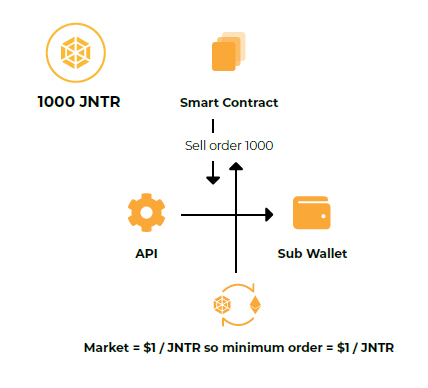
Daily mint based on Auction supply
The Jointer Auction mints JNTR based on the ongoing daily auction results. On Day 1 of the Auction, the starting mint will be 50,000 JNTR. The final amount minted is determined by the success of the Auction.
The previous day’s fundraising amount and the end of the day JNTR face value will determine the following day’s starting mint. This is calculated by taking the previous day’s total contributions6 and dividing that amount by JNTR’s face value at the end of the day.
Additional JNTR is potentially minted in accordance with group discounts and individual bonuses which is meant to reward investors for investing more than the daily auction’s goal.
Calculation

For example
If the previous day’s Auction investment was $1,000 and by the end of the current day’s Auction, the JNTR face value was $0.02, the minting supply for the following day will be 50,000 JNTR ($1,000/$0.02).
Example
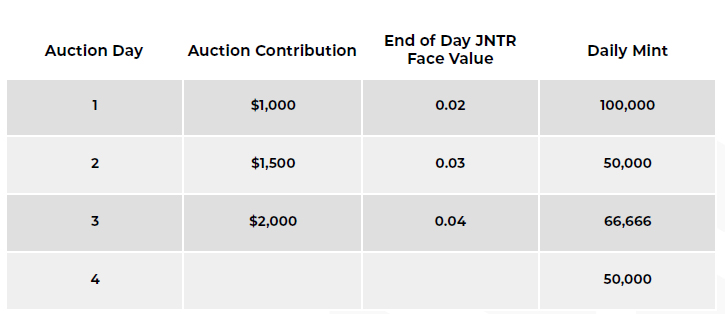
Future Split
Since JNTR has the ability to grow in value, there may come a time where the face value exceeds the psychological assessment of an opportunity to invest. In this case, Jointer may decide to split JNTR, giving users the equal face value of their JNTR with a comparable amount of JNTR at the face value of $0.01. This would not change the total value of the investors holdings, but the number of JNTR in their wallet proportionally increased to reflect the split.
Example
An investor holds 100 JNTR with a face value determined by Jointer’s Liquidity Reserve of $1,000. The investors total holdings equals $100,000 (100 x $1,000). Jointer announces a split JNTR splits and distributes JNTR proportional to the new price to JNTR holders The investor now holds 1,000,000 JNTR with a face value determined by Jointer’s Liquidity Reserve of $0.01, with the same total holdings of $100,000 (1,000,000 x $.01).
Purchasing JNTR
Investors have the ability to purchase JNTR assets in three ways:
Through the Auction at a potential 50% discount;
Through a Secondary Market Exchange or through;
Or SmartSwap.
Auction
Jointer’s auction allows investors to purchase JNTR assets on a daily basis. The daily supply is determined by the previous days’ investment. Auction investors receive a daily percentage of the asset allocation (supply), which will be split pro-rate amongst investors.
(See the Jointer Auction Section for more information on participating in the Jointer auction).
Investments made in the Jointer Auction, for JNTR, receive 90% downside protection which can be cancelled by investors at any time within 365 days. (See the Downside Protection for more information).
Secondary Market Exchange
Investors can purchase JNTR assets through cryptocurrency exchanges (LIMITED to non-US investors fulfilling Reg S requirements).
Regulated exchanges such as Alternative Trading Systems (ATS) and National Stock Exchanges such as Merj may offer a JNTR derivative.
Investors that buy JNTR assets are required to go through KYC (know your client) and AML (anti-money laundering) based on Reg S. Additionally, investors from the US and other regulated countries will need to conduct full accreditation checks based on Reg D 506(c).
SmartSwap

Jointer will allow users to swap JNTR through SmartSwap, which is powered by ElementZero (Jointer’s subsidiary company). SmartSwap provides investors a decentralized exchange bridge (DEX-Bridge) option with a Peer-to-Peer (P2P) and Peer-to-Community (P2C) trading technology built on the Binance Smart Chain. The trustless SmartSwap provides a way to swap assets and currencies without using a hot wallet, without signup, all while guaranteeing an exact face value match. SmartSwap’s asset-to-asset swaps are precise, low risk, and 100% fee-free.7
JNTR enjoys permanent permission to transfer to the SmartSwap contract. So, an investor can always swap JNTR through SmartSwap.
In addition, investors are able to trade JNTR using other P2P and P2C exchanges, such as Atomic Swaps. Such trades are limited between whitelisted wallet holders that have been cleared by Jointer for KYC and AML regulatory requirements and are subject to other regulations on a country-by-country basis. The transaction will fail if the receiving wallet is not whitelisted.
P2P Swap
SmartSwap P2P allows users to generate a transaction ID that can be sent directly to a specific person they want to swap with. Once the transaction ID is created and the users send their digital assets to that transaction ID, the swap will be available only to the party that knows the transaction ID address. Once the swap takes place, the SmartSwap will swap for the same face value, if there is any delta it will be returned to the appropriate party.
Example
- Bob wants to swap $1,000 JNTR with $1,000 BNB
- Bob sends his order to the SmartSwap and generates the transaction ID for the P2P swap
- Bob shares that transaction ID with Lisa
- Since Lisa only sent $500 BNB against Bob’s JNTR, the SmartSwap will execute the order of $500 JNTR against $500 BNB
- The SmartSwap will detect the value discrepancy between the JNTR and BNB, returning the $500 JNTR delta to Bob’s wallet
P2C Swap
SmartSwap P2C allows users to swap JNTR with other digital currencies without knowing the identity of the counterparty. If SmartSwap cannot find one counterparty to fulfill a transaction it will search for as many counterparties [^23] as needed to cover the face value and complete the transaction. [^24] A partial swap is completed first while the rest of the funds remain pending until additional swaps are executed. Users with pending swaps are allowed to cancel the outstanding portion of the swap and receive a refund covering the outstanding amount to the wallet of origin.
Example
- Bob wants to swap $1,000 JNTR with $1,000 BNB.
- Bob sends his order to SmartSwap and SmartSwap immediately identifies one counterparty that wants to swap $500 BNB against JNTR.
- In this case, Bob will get the first $500 BNB and the rest of the $500 JNTR will stay pending until the SmartSwap identifies more counterparties that want to swap BNB with JNTR.
Selling JNTR
Jointer provides investors with multiple options for selling their JNTR assets. Investors can redeem JNTR through the Jointer Liquidity Reserves or choose to avoid slippage and utilize the free swap above. Also, investors have an option to pay trading fees and place sell orders above or below the face value through Jointer’s secondary exchange partners.
Secondary Market Exchange
JNTR will be carried on exchanges to facilitate multiple options to sell JNTR. Investors have access to sell JNTR through Jointer’s exchange partners to purchase JNTR assets from other investors at the market rate.
Jointer Reserve Redemption
Jointer will establish the Liquidity Reserves on Day 1. As part of the multi-tier reserve process, Jointer will allocate 10% of the daily contributions to increase liquidity by purchasing JNTR from the reserve.
JNTR assets will be redeemable through Jointer’s Liquidity Reserves which adds multiple tiers of smart contracts above UNISWAP’s slippage protocol for fair redemptions and unlimited liquidity. Users will be able to redeem JNTR for BNB and other major cryptocurrencies plus stablecoins that are available.
Additional Protocol Above UNISWAP’s Technology
Jointer developed multiple smart contracts which interact with the protocol to provide strong, healthy, and sustainable liquidity. Through these additional smart contracts, JNTR investors enjoy reduced slippage impact on swaps and a stable face value against volatility.
To understand how the UNISWAP protocol reserve works visit: https://uniswap.org/docs/v2/protocol-overview/how-uniswap-works/
Read more about relay tokens, and slippage calculations in the “Establishing Jointer’s Liquidity Reserves” section of this paper.
Daily Reserve Limit
Jointer will limit all user’s wallet redemptions to one time per auction day. This implementation is utilized to discourage whales 8 from taking advantage of Jointer’s reserve through manipulative draining of the side reserve which is meant to limit slippage for all investors.
Jointer Reserve Circuit Breakers
Circuit breakers are useful tools employed by stock markets, banks, and other investment entities to protect asset value against black swan events causing a potential run on the bank scenario. Jointer utilizes a multi-tiered circuit breaker on Jointer’s Liquidity Reserves which protects JNTR’s face value.
Reserve Contribution Cap
Jointer developed an automatic reserve contribution cap that will prevent price manipulation or market volatility. The cap deposits to and withdrawals from the reserve in an automated, safe way. Even if the price succumbs to manipulation, the Jointer Reserve corrects itself instantly to maintain the JNTR face value before manipulation occured.
No Reserve Contribution Trigger
Jointer tested thousands of outcomes through game-theory action simulations in order to prepare for as much as possible. In order to maintain liquidity during a bear market, Jointer set up a no reserve contribution trigger. The trigger provides liquidity even when there is a day without any investment going to the reserves from the daily auction.
Target Investors
JNTR is attractive to investors due to its utility function within the Jointer syndication ecosystem and the volatility that exists with the asset class, allowing for high returns with lowered risk. These investors focus on a face value price driven by strong demand and a strong reserve to ensure liquidity.
Regulation
JNTR, from the US regulatory perspective, is a debt note. Investors that buy JNTR are required to go through KYC and AML based on Reg S. Investors from the US and other regulated countries will also need to conduct full accreditation checks based on Reg D 506 (c).9
In countries outside of the US, JNTR may not be viewed as a security, including Singapore, United Kingdom, and Hong Kong per opinion letters from law firms obtained by Jointer.
Management Fee
Jointer charges a management fee by minting 2%10 on top of the total daily minted supply. This fee goes to operational costs of the Jointer company and ongoing business operations.
Example
The minted supply for both the daily auction and staking reward equals 100,000 JNTR
- The smart contract mints the 2% management fee which equals 2,040.81 JNTR (100,000/0.98*2%) and sends it to Jointer’s company wallet Therefore, the total minted supply for that Auction will be 102,040.81 JNTR
- Therefore, the total minted supply for that Auction will be 102,040.81 JNTR
JNTR Quick Facts
JNTR is a liquidity bridge that serves as a transfer of value between traditional commercial real estate securities (JNTR/ETN and JNTR/STOCK) and digital currencies
JNTR’s face value is determined by the Liquidity Reserve and market demand
JNTR can be purchased or redeemed every day using Jointer’s Auction, Liquidity Reserves, secondary market exchanges, and SmartSwap
JNTR can be swapped to JNTR/ETN or JNTR/STOCK at any time
or BNB stablecoins and select other BNB cryptocurrencies ↩
https://www.nar.realtor/sites/default/files/reports/2017/2017-commercial-lending-trends-survey-05-18-2017.pdf ↩
Cryptocurrency global market cap is ~$238B as of January 20, 2020 ↩
Jointer reserves the right to use this investment to support liquidity until the organic market will be strong enough to support ongoing liquidity ↩
Or by using the Higher Ground Minting Rule mentioned in the Auction section of this document ↩
Gas and transaction fees are reimbursed with Element Zero’s native token ↩
A whale is an investor that holds a large amount of a certain digital asset ↩
Jointer has received legal guidance that JNTR is not a security in Singapore, Hong Kong, and the UK ↩
The 2% is fixed and cannot be altered by Jointer ↩